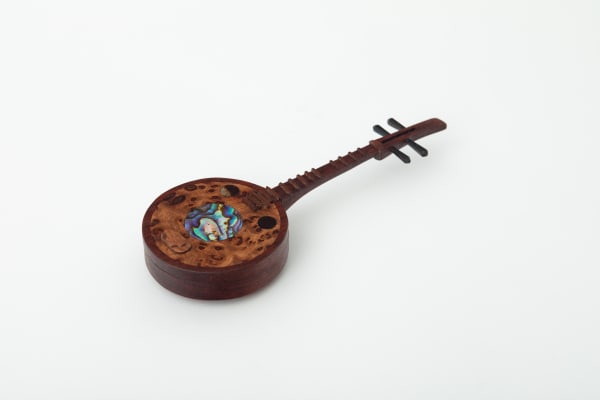-
 Hideyuki Fujisawa (b. 1972) studied lacquer at Lacquer Kosha. His work aims to perfect a lacquer version of the Yuteki Tenmoku Tea Bowl. His transformative use of traditional lacquer materials explores the use of brushing pure layers of lacquer over a carved wooden surface. Fujisawa strategically and meticulously places mother of pearl on the lacquer tea bowls, adding a touch of elegance and refinement.
Hideyuki Fujisawa (b. 1972) studied lacquer at Lacquer Kosha. His work aims to perfect a lacquer version of the Yuteki Tenmoku Tea Bowl. His transformative use of traditional lacquer materials explores the use of brushing pure layers of lacquer over a carved wooden surface. Fujisawa strategically and meticulously places mother of pearl on the lacquer tea bowls, adding a touch of elegance and refinement. -
 Terumasa Ikeda (b. 1987) is an innovative raden specialist; using a laser cutter, Ikeda fabricates shimmering mother-of-pearl Arabic numerals ingrained into the exterior of the lacquered box, creating a holographic luminescence that emanates from within. Ikeda takes a modern approach to his iconography, transforming the lacquer surface into the likeness of a digital screen. Ikeda’s futuristic vessels bridge the worlds of classical and modern lacquer.
Terumasa Ikeda (b. 1987) is an innovative raden specialist; using a laser cutter, Ikeda fabricates shimmering mother-of-pearl Arabic numerals ingrained into the exterior of the lacquered box, creating a holographic luminescence that emanates from within. Ikeda takes a modern approach to his iconography, transforming the lacquer surface into the likeness of a digital screen. Ikeda’s futuristic vessels bridge the worlds of classical and modern lacquer. -

Using chisels and planes, Tohru Matsuzaki (b. 1944) carves the basic forms for his work from valuable blocks of solid zelkova or chestnut wood, finishing them in thick coatings of Japanese urushi lacquer. He creates forms that appear simple but are highly refined; the vermilion red lacquer evokes images of the Jomon period (ca 11000 BC - ca 300 BC).
These unique works can be said to embody the essence of the Japanese ‘Mingei' folk craft movement.
-
 Imagining lacquer's endless possibilities from his Tokyo atelier, Jihei Murase (b. 1957) is a third-generation lacquer artist equipped with the skills acquired from a lifetime of training and a deep understanding of traditional techniques. Murase's innovative curving methods and mastery of the vermillion-coated Negoro style have made the artist a favorite of collections, including the Victoria & Albert in London, the Philadelphia Museum of Art, and the National Museum of Modern Art, among others. Murase's affiliation with the tea ceremony is deeply connected with his knowledge of traditional techniques. Yet, the artist constantly transforms wood, inventing new and unique forms.
Imagining lacquer's endless possibilities from his Tokyo atelier, Jihei Murase (b. 1957) is a third-generation lacquer artist equipped with the skills acquired from a lifetime of training and a deep understanding of traditional techniques. Murase's innovative curving methods and mastery of the vermillion-coated Negoro style have made the artist a favorite of collections, including the Victoria & Albert in London, the Philadelphia Museum of Art, and the National Museum of Modern Art, among others. Murase's affiliation with the tea ceremony is deeply connected with his knowledge of traditional techniques. Yet, the artist constantly transforms wood, inventing new and unique forms. -
 These two brothers Soyo (b. 1961) and Shodo Yamagishi (b. 1963) are unusual in that they specialize in creating ‘core lacquer’ objects, made entirely out of natural lacquer without the usual wooden core, that involve an unbelievably long and complicated process. They are continually studying to improve their technique and create an everlasting beauty that will never dull. The masterful technique of these brothers takes many years on end—up to twenty years for a single piece. The shinshitsu method means there is no wood interior; the core of the piece is made from lacquer itself and decorated by hand with eggshells, gold, silver, mother-of-pearl, and other sorts of precious mediums.
These two brothers Soyo (b. 1961) and Shodo Yamagishi (b. 1963) are unusual in that they specialize in creating ‘core lacquer’ objects, made entirely out of natural lacquer without the usual wooden core, that involve an unbelievably long and complicated process. They are continually studying to improve their technique and create an everlasting beauty that will never dull. The masterful technique of these brothers takes many years on end—up to twenty years for a single piece. The shinshitsu method means there is no wood interior; the core of the piece is made from lacquer itself and decorated by hand with eggshells, gold, silver, mother-of-pearl, and other sorts of precious mediums. -

Shinya Yamamura (b. 1960) is a lacquer artist who has mastered the mother-of-pearl inlay technique, raden. Appointed President of Kanazawa College of Art, Yamamura is inspired by the minuscule decorative elements of the pearlescent material. Each decoration is a meticulous process involving countless hand-cut abalone shells attached to the zelkova elm within polished layers of lacquer. Yamamura’s works are in collections worldwide, including the Victoria & Albert Museum in London, the Los Angeles County Museum of Art, and the 21st Century Museum of Contemporary Art in Kanazawa. Lacquer, mother-of-pearl, abalone shell, ivory, paper-thin pieces of shellfish, eggshell, powdered gold, silver or iron…the exquisite works are small enough to be held in the palm of one’s hand yet contain microcosms of precious materials.
![Hideyuki Fujisawa Gold Tenmoku Lacquer Tea Bowl [Set] 黄金天目茶椀, 2025 Urushi lacquer, Zelkova elm, gold leaf](https://artlogic-res.cloudinary.com/w_600,c_limit,f_auto,fl_lossy,q_auto/artlogicstorage/ippodogallery/images/view/8e090f5688331f334fb2e3874ac2cb4cj/ippodogallery-hideyuki-fujisawa-gold-tenmoku-lacquer-tea-bowl-set-2025.jpg)
![Hideyuki Fujisawa Gold Tea Bowl Lacquer Stand [Set] 金天目台, 2025 Urushi lacquer, Zelkova elm, gold leaf](https://artlogic-res.cloudinary.com/w_600,c_limit,f_auto,fl_lossy,q_auto/artlogicstorage/ippodogallery/images/view/864483612d14eb675e66639c0adffbc1j/ippodogallery-hideyuki-fujisawa-gold-tea-bowl-lacquer-stand-set-2025.jpg)












![Soyo and Shodo Yamagishi Sinshitsu Lacquer Incense container [Long-Tail Fowls] - 芯漆 尾長鶏香合, 2024 Lacquer](https://artlogic-res.cloudinary.com/w_600,c_limit,f_auto,fl_lossy,q_auto/artlogicstorage/ippodogallery/images/view/34fc9202aa8c2b3e7b18a2608ecb1ef0j/ippodogallery-soyo-and-shodo-yamagishi-sinshitsu-lacquer-incense-container-long-tail-fowls-2024.jpg)
![Soyo and Shodo Yamagishi Sinshitsu Lacquer Incense Container [Mandarin Duck] - 芯漆 オシドリ香合, 2024 Lacquer](https://artlogic-res.cloudinary.com/w_600,c_limit,f_auto,fl_lossy,q_auto/artlogicstorage/ippodogallery/images/view/139ee30bdfad1b5cde40e9cceebdd6dcj/ippodogallery-soyo-and-shodo-yamagishi-sinshitsu-lacquer-incense-container-mandarin-duck-2024.jpg)
![Soyo and Shodo Yamagishi Sinshitsu Lacquer Tea Bowl [Blue Universe] - 芯漆抹茶椀 青宇宙, 2024 Lacquer](https://artlogic-res.cloudinary.com/w_600,c_limit,f_auto,fl_lossy,q_auto/artlogicstorage/ippodogallery/images/view/fe673f51671feb98f041f95f9a0cce1dj/ippodogallery-soyo-and-shodo-yamagishi-sinshitsu-lacquer-tea-bowl-blue-universe-2024.jpg)

![Shinya Yamamura 金杢目塗菱形小箱 - Kin-Mokume-Nuri Small Container [参考作品], 2019 Lacquer](https://artlogic-res.cloudinary.com/w_600,c_limit,f_auto,fl_lossy,q_auto/artlogicstorage/ippodogallery/images/view/d383b50a295d3cfc78754d8bf845c22a/ippodogallery-shinya-yamamura-kin-mokume-nuri-small-container-2019.jpg)